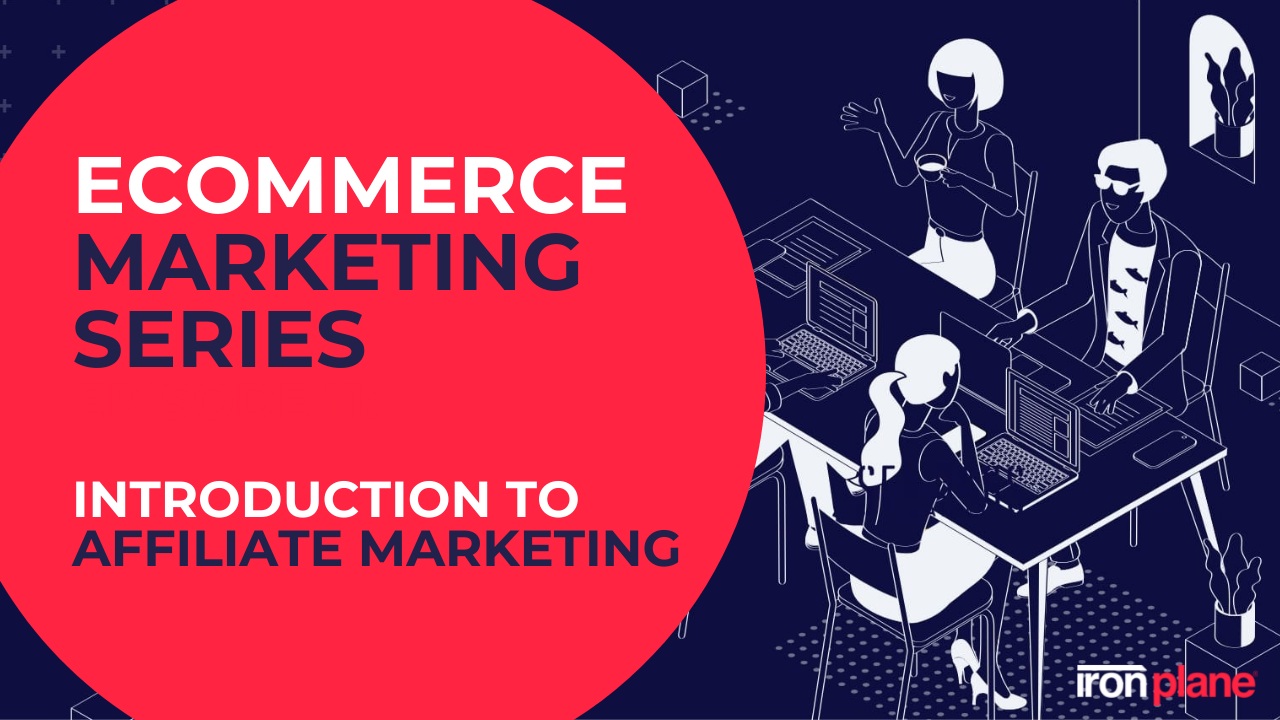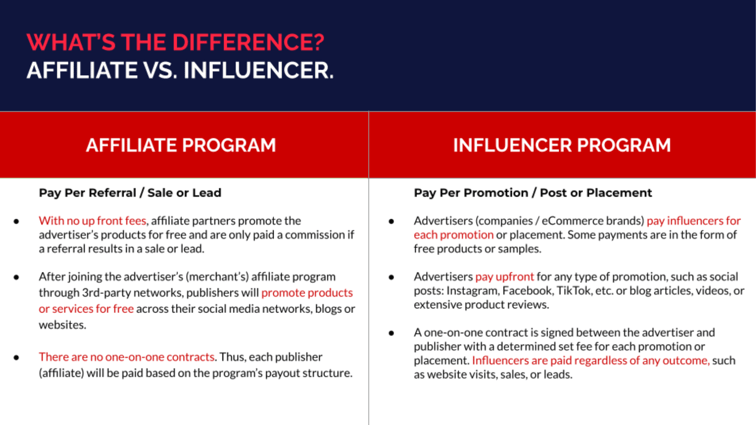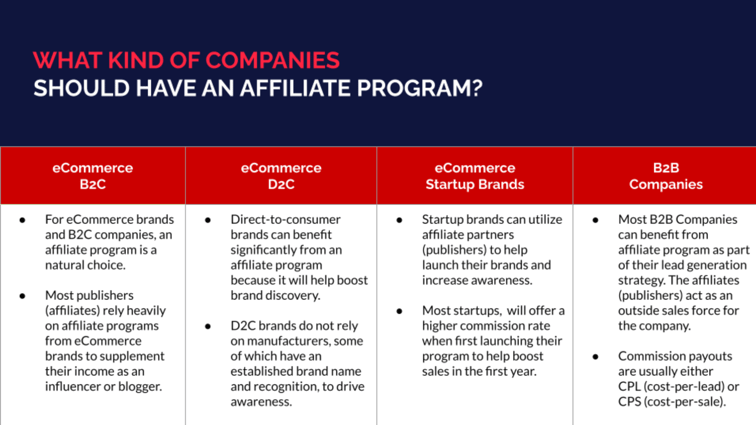Top 5 eCommerce Digital Marketing Programs to Increase Sales
Want more sales? Learn the top five eCommerce digital marketing and social media programs to increase website traffic and boost online revenue.
7 min read
 Tim Bucciarelli
:
May 3, 2022
Tim Bucciarelli
:
May 3, 2022

In this episode of our eCommerce Marketing Series, Digital Media Manager Susan Rapp gives an introduction to Affiliate Marketing. Plus, she talks about how brands can utilize affiliate programs to boost awareness, amplify reach, and increase eCommerce sales.
Affiliate programs generate qualified leads, increase website traffic, and increase sales. With no up front fees, affiliate partners promote your products and are only paid a commission if a referral results in a sale. It’s a win-win for brands.
Visit the Shaping eCommerce Channel on Youtube to watch our full eCommerce Marketing Series.
We release new content every week, so please subscribe to our channel
and make sure to hit the notification bell!

One of the things I want to talk about is the difference between affiliate and influencer. While there are a lot of similarities, there are some slight nuances that make them different. Affiliate Programs / Pay-Per-Referral: Sale or Lead
(01:42) First, an affiliate program is a pay-per-referral - sale or lead. With no upfront fees, affiliate partners promote the advertiser's products for free and are only paid a commission if a referral results in a sale or lead. Then after joining the advertiser's or the merchant's affiliate program through third-party networks, publishers will promote products or services for free across their social media networks, blogs, or websites.
One very important thing to know is that there are no one-on-one contracts with affiliate marketing. So each publisher or affiliate will be paid based on the program's payout structure.
(02:25) When I say there are no "one-on-one contracts." What I mean is that you're not going out and finding individual influencers or finding affiliates and asking them to be part of your program and negotiating a rate for each promotion, saying, "We're going to pay you $500 for a specific social media post."
When an affiliate joins your affiliate program on a third-party network (like Rakuten or CJ), that is considered their contract. So as a merchant within the affiliate platform and in the payout commission structure, you say, for example, "We're going to pay any affiliate who brings us a sale 7% commission (or this could also be pay-per-lead).
When you compare this to influencer programs, which are pay-per-promotion, where Advertisers (companies or eCommerce brands) will pay influencers for each promotion or placement, also, payments to influencers can come in the form of free products or samples.
(03:23) The advertiser pays upfront for any type of promotion, such as a social media post on Instagram, Facebook, TikTok, etc. This can also be a blog article, video, or an extensive product review. Then, a one-on-one contract is signed between the advertiser and the publisher with a determined set fee for each promotion or placement.
One of the most important things to realize is that influencers are paid regardless of any outcome. This is true even if you received zero sales, comments, or website visits from their paid promotion or post. Thus, this is a very important difference between influencer and affiliate marketing.
In contrast, the affiliate is out there promoting your products and your services for free on their blogs, websites, and social media channels. However, once they bring you a sale or a lead, you will pay the affiliate the pre-determined commission or cost-per-sale.
For this reason, affiliate programs are such a win-win for brands. Moreover, they're definitely more of a win-win for brands than for the affiliate promoting your products, and that's for all the reasons we just discussed in terms of them promoting your products "upfront" for free.
%20copy.png?width=756&name=Affiliate%20Marketing%20-%20Video%20Deck%20-%20Draft%20(1)%20copy.png)
Now we're gonna talk about affiliate marketing programs and what they can do for companies. So affiliate programs generate qualified leads, increase website, traffic, and increase sales. And here are some stats:
The year 2020 changed a lot of things for eCommerce brands. Here are some industry stats and growth metrics.
This definitely shows you the value of having an affiliate marketing program for eCommerce brands, but it also shows that a lot of B2B companies, who want to get more lead generation, can promote an affiliate marketing program to get new leads and sales.
%20copy%203.png?width=756&name=Affiliate%20Marketing%20-%20Video%20Deck%20-%20Draft%20(1)%20copy%203.png)
1. Increase Sales and Website Traffic
A well-developed affiliate program is a significant revenue driver and operates as an outside sales team for your business. Plus, with each promotion, publishers are driving traffic to your website.
2. Amplify Reach and Awareness
Build brand equity, amplify brand reach, and increase awareness with affiliate programs. Publishers with large social media audiences will help build awareness for your brand.
3. Brand Equity and Social Proof
By partnering with publishers who have an engaged audience, you will build brand equity and they will provide social proof of your products or services. It’s a win-win for brands.
-1.png?width=756&name=Affiliate%20Marketing%20-%20Video%20Deck%20-%20Draft%20(2)-1.png) Affiliate Marketing General Definitions (8:07)
Affiliate Marketing General Definitions (8:07)Affiliate Marketing
Affiliate marketing is an advertising model in which a company or advertiser compensates third-party publishers when a transaction results in a sale or lead.
Affiliate Network
A 3rd-party affiliate network, such as Rakuten, ShareASale, or Commission Junction hosts your affiliate program and provides tracking, reporting, communication tools, and payouts to affiliate publishers. These networks have thousands of publishers that utilize their platforms to find merchants and products to promote.
Advertiser or Merchant
The advertiser or merchant (eCommerce store), sells products or services and is looking for publishers (affiliates) to promote their products in exchange for a commission or fee.
Publisher - The “Affiliate”
The publisher, also known as the affiliate, is the promoter of the advertisers’ or merchants’ goods or services. Publishers have an established network, social media audience, and most have a blog or website. The majority of publishers have a specific niche, lifestyle, or a personal brand and engage frequently and authentically with their followers.
CPS, CPL, and CPC
These are commission payout models and are determined by the individual advertiser or merchant within the affiliate network account. Once a transaction is complete, the network will pay the publisher on the next payment cycle.
%20copy%204.png?width=756&name=Affiliate%20Marketing%20-%20Video%20Deck%20-%20Draft%20(1)%20copy%204.png)
So you have an e-commerce website or sell B2B services and you want more sales.
1. You join a major affiliate network and set your commission structure. Then you load your products into the platform or allow for smart linking directly from your e-commerce product pages, which I highly recommend. You add all the tracking codes to the backend of your website (and within the affiliate network). Now everything's set up.
2. Publishers (affiliates) join your program via the affiliate network, and you approve them. Now, you can approve them one by one, or you can just set your program to auto-approve. A lot of startup brands and D2C brands will set it to auto-approve. I highly recommend approving most of the affiliates - especially if you are launching your program.
3. Next, the publisher (affiliate) finds an item on your website to promote. It fits their brand. It fits their lifestyle. They want to promote it on their blog. So they publish the item, along with the affiliate code link, on their blog or website. They can also use the affiliate link across their social media channels. Now they have a tracking link on all the products they're promoting for you. Then they start promoting your products for free, which is the best part. Once they bring you a customer and that customer completes a purchase - you will pay them the set commission rate.
4. A consumer clicks on the affiliate link from the publisher (affiliate) and is directed to your website.
5. The customer completes the purchase. The third-party affiliate network (Rakuten, ShareASale, etc.) tracks the details of this transaction via the affiliate codes.
6. Finally, the affiliate network pays out the commission to the publishers through your affiliate account, and the affiliate receives the payout in the next payment cycle.
%20copy.png?width=756&name=Affiliate%20Marketing%20-%20Video%20Deck%20-%20Draft%20(2)%20copy.png)
Some well-established brands with affiliate programs that you're probably familiar with are Amazon, Target, and Wayfair. Then you have some fashion and lifestyle brands, Urban Outfitters, Nordstrom, Free People, and REVOLVE. Other brands include Zappos, Godaddy, Microsoft, and Go Pro. It's across all verticals. Most major brands will have an affiliate program.
In fact, according to TrueList 2022, more than 80% of brands have affiliate programs. Nearly 65% of affiliate marketers generate traffic by blogging, and 94% of publishers use multiple affiliate marketing networks.
%20copy%205.png?width=756&name=Affiliate%20Marketing%20-%20Video%20Deck%20-%20Draft%20(1)%20copy%205.png)
By joining an established affiliate network, such as Rakuten, ShareASale, CJ (Commission Junction), AWIN, or Impact Radius, you will have access to an existing network of tens of thousands of publishers who are looking for brands and products to promote. The Largest Affiliate Networks Have 100K+ Active Affiliates: ShareASale: 700,000+ and Awin: 205,000+
3rd-Party Affiliate Networks
These 3rd party affiliate networks provide tracking, reporting, communication tools, and payouts to affiliate publishers. Costs vary by network and most charge transaction fees based on commission payouts, and some networks charge a monthly fee and/or set-up fees.
Despite the additional costs, within these networks, you will grow your affiliate partnerships significantly faster than if you were to use a stand-alone, in-house program, or software plugin.
Stand-Alone Affiliate Programs
By launching a stand-alone program on your website, you will be solely responsible for program management, payouts, tracking, etc. Additionally, you will not have an existing pool of publishers to join your program and you will need to allocate significant time and marketing costs for publisher outreach, onboarding, and program management.

What Kind of Companies Should Have an Affiliate Program? (15:54)
eCommerce B2CeCommerce D2C
Direct-to-consumer brands can benefit significantly from an affiliate program because it will help boost brand discovery. D2C brands do not rely on manufacturers, some of which have an established brand name and recognition, to drive awareness.
eCommerce Startup Brands
Startup brands can utilize affiliate partners (publishers) to help launch their brands and increase awareness. Most startups will offer a higher commission rate when first launching their program to help boost sales in the first year
B2B Companies
Most B2B Companies can benefit from affiliate programs as part of their lead generation strategy. The affiliates (publishers) act as an outside sales force for the company. Commission payouts are usually either CPL (cost-per-lead) or CPS (cost-per-sale).
Want more sales? We are ready to build you a revenue-generating affiliate program with a network of engaged affiliate partners and influencers. Click here to schedule a free consultation today!
IronPlane is an eCommerce Solutions Partner that provides integrated services tailored to your business goals. IronPlane offers web development solutions in Adobe / Magento and BigCommerce and delivers integrated marketing strategies across channels to increase brand awareness, website traffic, and online revenue.

Want more sales? Learn the top five eCommerce digital marketing and social media programs to increase website traffic and boost online revenue.

Are you looking to boost sales? Learn the key strategies to implementing an effective affiliate marketing to drive eCommerce sales.

Are you ready to jumpstart your social media marketing programs? Learn the Top 10 eCommerce social media marketing strategies to drive revenue.